Press [+] to the left of a session to show the details of that session (and on [-] to hide). Or [++]/[--] at the top of the page to expand or collapse all of them together.
trans-local Sympodium
What’s Wrong with Performance Art?
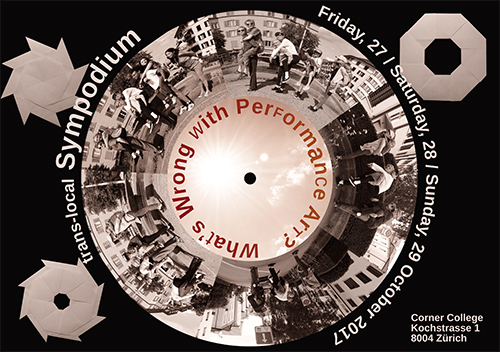
Friday, 27 October, 12:30h doors open, coffee / tea / buffet
13:00h Introduction by the curators
Curatorial Input / Kuratorischer Input
[en]
The Sympodium sets up a two-and-a-half days live event that aims to provide a platform for presenting, discussing and performing Performance Art in performative sessions throughout a panel structure with an accent on moderated discussions and performances. The Sympodium strives to generate an energetic open space for aesthetic experience and exchange of knowledge between the current active practitioners in the field of Performance Art(s): artists, curators, performance study researchers, educators, and their publics, those who are committed to Performance Art will share their practices, experience, reflections, thoughts, and research.
The Sympodium is a podium that encourages invited participants to give a very direct subjective response from the material objectives of the event itself. The Sympodium is quasi-academic, and serves to bring together practitioners inside and outside Academia to give them a podium to publicly present and discuss their practices and modes of articulation and action. The Sympodium operates within the local, interregional and international Performance Art scene. It strives for different perceptions and a new ontology of the relation between Performance and Art, and a pattern of branching that expands the field of live practices.
Read the curatorial input in full (in printable format as PDF, 107KB)
[de]
Das Sympodium stellt in einer zweieinhalbtägigen Live-Veranstaltung eine Plattform zur Verfügung zum Präsentieren, Diskutieren und Performieren von Performance Art, in einer performativen Podiumsstruktur mit Schwerpunkt auf moderierten Diskussionen und Performances. Das Sympodium strebt danach, einen energischen offenen Raum zu erzeugen für ästhetische Erfahrung und den Wissensaustausch zwischen den heute aktiven Praktiker_innen im Bereich der Performance Art(s): Künstler_innen, Kurator_innen, sowie Forscher_innen und Pädagog_innen zu Performance, und ihr Publikum, jene, die der Performance Art verpflichtet sind, teilen ihre Praktiken, Erfahrungen, Überlegungen, Gedanken und Forschung.
Das Sympodium lädt als Podium die Teilnehmer_innen ein, aus den materiellen Zielen des Ereignisses selbst eine sehr direkte subjektive Antwort zu geben. Das Sympodium ist quasi-akademisch und dient dazu, Praktiker_innen inner- und ausserhalb der akademischen Welt zusammen zu bringen und ihnen eine Plattform zu bieten, ihre Praktiken und ihre Artikulations- und Aktions-Modi öffentlich vorzustellen und zur Diskussion zu stellen. Das Sympodium operiert mit der lokalen, interregionalen und internationalen Performance Art-Szene. Es streicht unterschiedliche Wahrnehmungen heraus und erarbeitet eine neue Ontologie des Verhältnisses zwischen Performance und Kunst, in einem Verzweigungsmuster, welches das Feld der Live-Praktiken erweitert.
The Sympodium is supported by Kultur Stadt Zürich, Fachstelle Kultur Kanton Zürich, Pro Helvetia and Ernst und Olga Gubler-Hablützel Stiftung.
Hier der vollständige Text des kuratorischen Inputs (in druckbarem Format als PDF, 138KB)
13:30h Artist Talk Performance as Book. Book as Performance by Martina-Sofie Wildberger in conversation with Georg Rutishauser in the context of her personal exhibition at Corner College and her collaborative book project with edition fink / Georg Rutishauser.
Martina-Sofie Wildberger
[de]
In ihrer künstlerischen Arbeit setzt sich Martina-Sofie Wildberger seit etlichen Jahren mit der Dokumentation von Performance auseinander. Wie kann eine Performance über ihre Unmittelbarkeit erfahrbar gemacht werden? Was verliert sich und was wird neu gewonnen bei einer medialen Übersetzung? Vom Buch über Poster zum T-Shirt hat die Künstlerin diese Fragestellung verschiedenst experimentiert. Im Rahmen der Ausstellung von I WANT TO SAY SOMETHING im Corner College zeigt sie graphische Darstellungen ihrer Performance SPEAK UP!, die zusammen mit dem Berner Grafikbüro B & R entwickelt wurden und die als Künstlerbuch bei edition fink erscheinen werden.
In diesem Artist Talk Performance as Book. Book as Performance. präsentiert Martina-Sofie Wildberger einerseits einen Teil ihrer früheren Arbeiten, die sich mit der Dokumentation von Performance auseinandersetzten, andererseits wird sie mit Georg Rutishauser ihr aktuelles Buchprojekt vorstellen.
[de]
In her artistic work, Martina-Sofie Wildberger has explored ways of documenting performance. How can a performance be made tangible through its immediacy? What is lost, and what is newly gained in a medial translation? From book and poster to T-shirt the artist has experimented on this question in the most varied ways. In the context of the exhibition I WANT TO SAY SOMETHING at Corner College she shows the graphical presentation of her performance SPEAK UP!, which she developed together with the Bernese graphic studio B & R and will be published as an artist book by edition fink.
In this artist talk Performance as Book. Book as Performance., Martina-Sofie Wildberger presents on the one hand her earlier works that deal with the documentation of performance; on the other, together with Georg Rutishauser she will present her current book project.
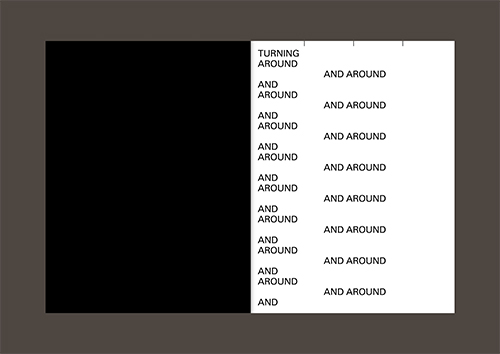
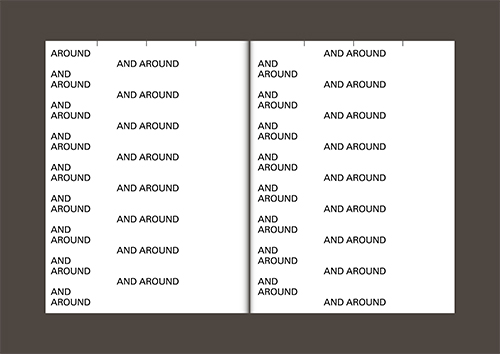
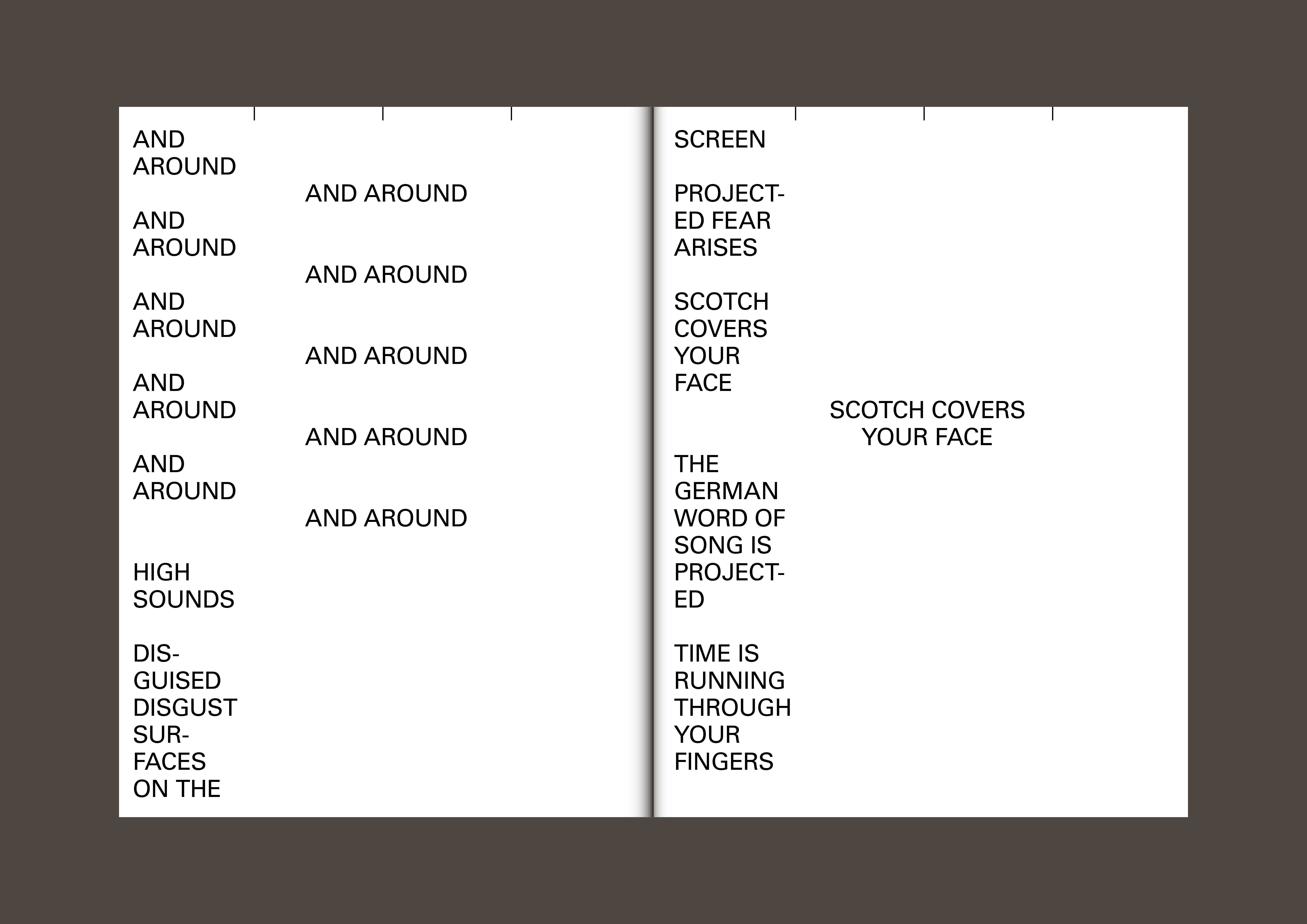
14:00h Session 1 Performing the Curatorial / Curating Performance with Chris Regn, Madeleine Amsler, Sibylle Omlin and Elise Lammer, moderated by Irene Müller
16:05h panel discussion
Chris Regn
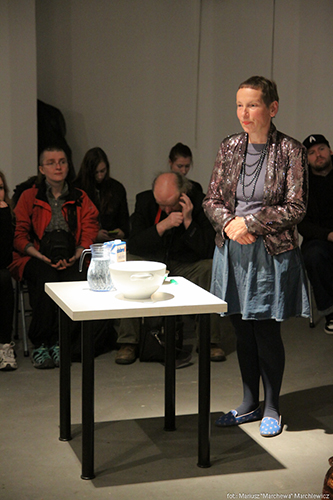
Chris Regn. Photo: Mariusz «Marchewa» Marchlewicz
[de]
Seit ich Muda Mathis kenne, mache ich auch Performance in der Kunst und nicht wie vorher nur in subkulturellen und politischen Zusammenhängen. Sogar in meiner Meisterschülerzeit an der Kunsthochschule habe ich eine Performanceklasse gemacht, die die gemeinsamen Räume genutzt hat und die für das Gemeinsame und Autonome wirklich erhellend war.
Für mich ist es immer und jetzt neu mit dem PerformanceNetzwerk PANCH wirklich interessant, wie Begriff und Praxis sich in jedem Feld und jeder Region neu ausformulieren können und auch wollen. Wir können Raum herstellen und begehen und immer wieder gespannt sein. Viva: Treffen wir uns in der Performance!
[en]
Since I’ve known Muda Mathis I’ve also done performances in art and not only, as I did before, in subcultural and political contexts. Even in my times as master student at the art academy I took a performance class, which used the common spaces and was truly revealing both for the common and the autonomous.
For me it is always interesting, and now specifically with the PerformanceNetzwerk PANCH, how concept and practice in every field can and want to reformulate themselves. We can create and walk space and wonder every time again. Viva: Let’s meet in the performance!
Madeleine Amsler
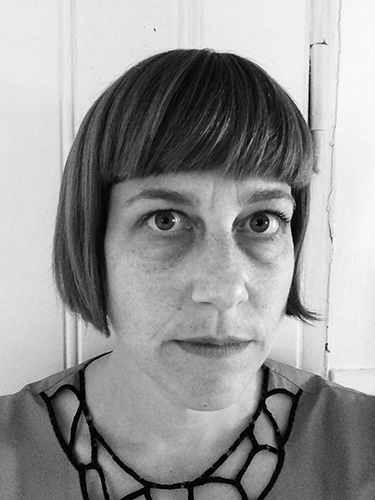
Madeleine Amsler (Selfie)
[de]
Wenn ich Performance-Anlässe kuratiere, lade ich Künstlerinnen ein, deren Werk mich als Ganzes interessiert, um dann mit ihnen zusammen eine neue Produktion zu realisieren an einem spezifischen Ort. Ich arbeite fast nie mit Themen wenn ich Performance-Anlässe kuratiere, da, wenn ein Thema vorgegeben ist, die Künstlerinnen fast eher einem Auftrag (da es ja neue Produktionen sind) folgen, als ihre Idee zu verfolgen und umzusetzen.
Die Performance als Medium der Visuellen Künste besticht durch seine Unmittelbarkeit und Konfrontation des Publikums mit dem/der Künstler/-in und/oder Performer/-in. Zudem fasziniert mich die ephemeren Existenz der Performance, sie lässt sich nie ganz fassen. Die Idee des/der Künstler/-in bekommt während einer bestimmten Dauer eine Form, die sich danach wieder entmaterialisiert aber gleichzeitig weiterbesteht.
[en]
When I curate performance events I invite artists whose work I’m interested in as a whole, in order to realize with them a new production in a specific place. I almost never work with topics when I curate performance events, because when a topic is given, the artists rather follow a commission (since they are new productions) than following and realizing their idea.
Performance as a medium of visual art stands out with its immediacy and confrontation of the public with the artist and/or performer. What’s more, I am fascinated by the ephemeral existence of the performance, which can never be fully grasped. The idea of the artist receives a form for a certain duration, in order to then dematerialize while at the same time continuing to exist.
Sibylle Omlin
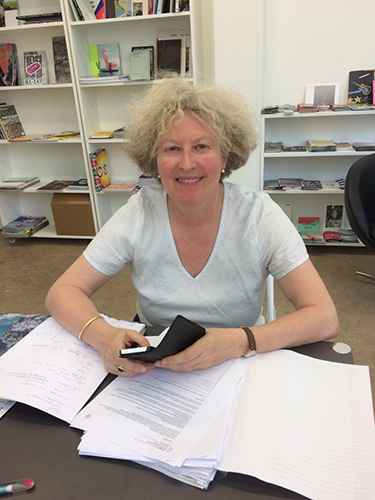
Sibylle Omlin im Kunstraum Kreuzlingen. Photo: Gudrun Bielz
[de]
Die Beschäftigung mit der Performance ist in meiner Tätigkeit als Kunstwissenschaftlerin vor allem eine Arbeit der Beobachtung, Reflexion, aber auch Kuration. Die Performance hat sich in den letzten 15 Jahren nachhaltig verändert durch digitale Medien und (bildliche und schriftliche) Dokumentationen, die es vorher in der Form nicht gab. Vor allem der Einbezug von dokumentarischen, kompositorischen und sprachlichen Praktiken in die Performance ist ein Umstand, der die Live-Situation der Performance verändert und mitunter auch in ein Ungleichgewicht bringt. Wie wirken Live und Improvisation in einer Lecture performance, die von einem Skript ausgeht? Wie verändern choreographische und kompositorische Elemente das authentische Agieren des/der Performers/in? Was macht der Körper noch in der Performance? Durch Ausstellungen, aber auch Texte/Publikation versuche ich diesen Fragen nachzugehen. Die Erkenntnisse sind nicht immer klar, eher in Wandlung. Die Verbindung zwischen einem guten Live act des Körpers, Choreographie, Performance-Objekt und/oder gutem Text bringt mich immer in Entzücken, dann zum Nachdenken. Performance boomt – das ist fein – , doch hoffentlich haben wir genügend Zeit zum Reflektieren, Vergleichen, Verstehen.
[en]
In my activity as an art scholar, dealing with performance is mainly a work of observing, reflecting, but also curating. Performance has durably changed over the past 15 years, due to digital media and (image and written) documentation that was not available in this form before. Especially the inclusion of documentary, compositional and linguistic practices in performance has changed the live situation of performance and occasionally brings it into disbalance. What is the effect of the live situation and of improvisation in a lecture-performance based on a script? How do choreographic and compositional elements change the authentic action of the performer? What does the body still do in a performance? Through exhibitions, but also texts/publications I try to pursue these issues. The findings are not always clear, rather in mutation. The relation between a good live act of the body, choreography, performance object and/or a good text never fail to delight me, and then get me thinking. Performance is booming – that’s fine – , let’s just hope we still have sufficient time to reflect, compare, understand.
Elise Lammer

Elise Lammer. Photo: Nelly Rodriguez, David Wohlschlag, Greg Clément
Almost invisible. On performance and domestic space.
Irene Müller
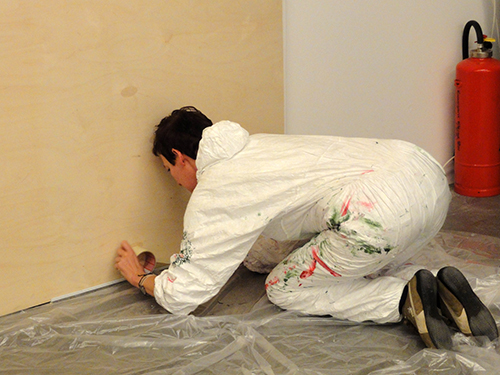
Irene Müller, Der Beweis, 2010. Photo: Marianne Halter
[de]
Performancekunst ist ebenso ein Unwort wie Videokunst oder Medienkunst. Eine begriffliche Hilfskonstruktion, die nach Kanonisierung klingt und Nobilitierung bzw. «kulturellem Wert» oder (kulturpolitische / finanzielle) Wertschöpfung verheisst. Trotzdem wird der Begriff von den unterschiedlichsten Akteur/innen immer wieder verwendet, vor allem auch wenn die sprachliche Notwendigkeit besteht, sich innerhalb gegebener Förder- und Präsentationsstrukturen zu positionieren.
Verdeckt wird dadurch oft die Frage nach Qualität und Dringlichkeit, nach inhaltlichem Gehalt und adäquater Umsetzungsform der entsprechenden künstlerischen Interessen. Viele Aspekte von Performances – z. B. Liveness, Publikumsbezug, politischer / historischer / kultureller Kontext, formale Ausrichtung – erschweren die Ausbildung einer sprachlichen Reflexion, die einerseits über das rein Deskriptive, die Reflexion des persönlichen Erlebens hinausgeht, und andererseits aber auch nicht im rein Theoretisch-Diskursiven verbleibt.
«Performances zu kuratieren» bedeutet immer auch, die Chance der «Versprachlichung» zu ergreifen, über Wort und Bedeutungen nachzudenken, gängige Formulierungen über den Haufen zu werfen und von den konkreten Arbeiten, künstlerischen Positionen und Haltungen aus zu denken.
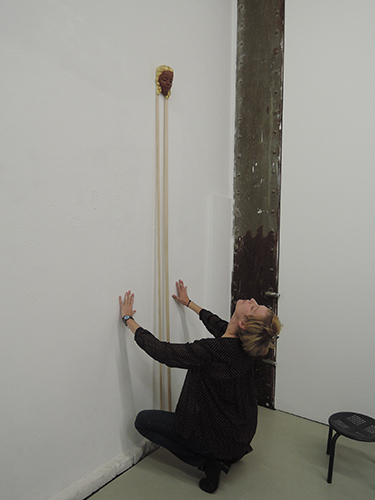
Irene Müller, 2015. Photo: Dorothea Rust
[en]
Performance art is a term that might as well be banished, like video art or media art. A conceptual auxiliary construction that sounds like a canonization and ennobling, or cultural value, and holds the promise of (cultural-political / financial) value added. Nonetheless the term is used time and again by all sorts of actors, especially when there is a linguistic need to position oneself within given funding and presentation structures.
This often obscures the question of quality and urgency, of contentual substance and suitable forms of implementation of the respective artistic interests. Many aspects of performance – e.g., liveness, contact with the public, political / historical / cultural context, formal orientation – hampers the formation of linguistic reflection that on the one hand would go beyond the purely descriptive while on the other, not remaining in the purely theoretical-discursive.
«To curate performances» always also means to seize the opportunity of a verbalization, reflect on words and meanings, nix common wordings and think from the perspective of concrete works, artistic positions and attitudes.
Heike Fiedler

[org]
My horizon is the situation or the body in space. My strategy is the in between: the in between of the written and the spoken, the in between of languages, of what is meant to be fixed. My tactics are technology, the voice and sounds of words. Mon horizon, ce sont les sons des langues, la voix, ma stratégie est la situation ou le corps dans l’espace, l’entre-deux est ma tactique. Die Zwischenräume sind mein Horizont, meine Strategie die Laute der Sprache und Technik. Die Taktik ergibt sich aus der jeweiligen Situation, aus dem Körper im Raum.
The word sympodium reminds me the idea of rhizomes, as expressed by Deleuze et Guattari, to whom you refer in terms of mapping. Dans ce sens, la performance doit rester un devenir pluriel et ce Sympodium que vous organisez en est l’expression par excellence !! :) So, what should be ..on. .it. .s
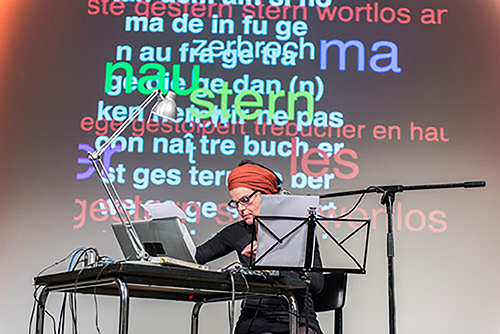
Heike Fiedler, Performance im Literaturhaus Basel. Photo: Literaturhaus Basel
[en]
My horizon is the situation or the body in space. My strategy is the in between: the in between of the written and the spoken, the in between of languages, of what is meant to be fixed. My tactics are technology, the voice and sounds of words. My horizon, that’s the sounds of languages, the voice; my strategy is the situation or the body in space; the in-between is my tactics. The interstices are my horizon, my strategy is the sounds of language and technology. The tactics arises from the respective situation, from the body in space.
The word sympodium reminds me the idea of rhizomes, as expressed by Deleuze et Guattari, to whom you refer in terms of mapping. In this sense performance must remain a plural becoming, and this Sympodium you are organizing is its expression par excellence !! :) So, what should be ..on. .it. .s
Nathalie Rebholz
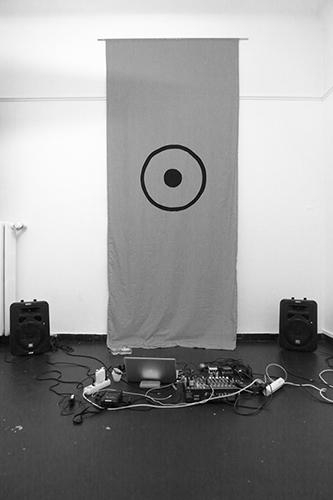
View after the performance Fixe Point, for the show There is no way as one way in, Placette, 2017
<obscene-micelium.jpg>
Linda Cassens Stoian: Out on the Limb: Gaining Insight into MOTILITY as Critical Spatial Praxis
_1970-m.jpg)
Street Action (M-Walk), 1970 (Yvonne Rainer, Douglas Dunn, Sarah Rudner in the first row). Photo: Yvonne Rainer. Source: Yvonne Rainer video, Archive: The Getty Research Institute, Los Angeles (2006.M.24)
Taking up the sympodium concept – according to Merriam-Webster – and using it to situate the praxis and discourse of performance art, insight gained out on a limb means, first of all, to consider art itself as: “a main axis (as in a grapevine) [or the branching of a tree] that has not developed from a terminal bud but as a series of successive secondary axes, each of which represents one fork of a dichotomy of which the other fork is of weaker growth or suppressed entirely.” Thereby, at the onset of any venture in the arena of “‘smuggling’ incorrect, illegal, twisted, crooked and related strategies to subvert existing rigid values, breaking down categories as the artist attempts to push boundaries in new, unexpected ways and indicate new directions…” [Sympodium Concept Paper 2017, p. 1], the dilemma of going out onto “other forks,” i.e., branches of weaker or suppressed growth, is to be faced. What this means is not only to acknowledge the (pre-given, already established, never to be redeemed) weaker status of performance art in the larger branching of art, but also accept the premise that going out on any further vines or branches is a precarious endeavor indeed.
My undertaking then in the context of this Sympodium is to follow the MOTILITY fork, presenting case studies entailing moving through and lingering in urban space, [auf deutsch, das Durchlaufen aber auch das Zusammennehmen, to move through yet bring disparate maneuvers together to a conclusion] – which has it’s own further branches, e.g., ART-, ARCHITECTURE (BaukulTOURen) tours & tourism, art walks, audio walks, conceptual walks, dialogical walks, dérives, ramblings, silent walks, Streifzüge, talk walks, urban safaris, etc., not to mention, à la sociologist and urbanist Lucius Burckthardt’s promenadologie (Fr.)/ strollogy (Eng.)/ Spaziergangswissenschaft (De.). Exploring and testing the political and aesthetic potentialities of such a branch, my presentation will map out concrete elements of artistic strategies and concepts of specific artists, whose repertoire includes addressing, but does not focus exclusively around, MOTILITY; curatorial concepts featuring MOTILITY strategies and concepts in exhibitions; and, MOTILITY methods and terminology developed in the sense of a tool set for MOTILITY ventures for students in higher education seminars, workshops, and modules.
Some of the underlying questions as a through-line in the context of the Sympodium include: Without getting lost in a “history of performance art”, what is there to be learned nonetheless in studying where and when such a branch as MOTILITY sprouted from the “trunk” of performance art? In what ways does this branch of MOTILITY resist the Zeitgeist – and, in response to what needs and trends has it emerged? And, how is this MOTILITY branch “useful“ in a didactic sense–for teachers, students, public, mediators–in a critical praxis, i.e., what might be a sound approach on the precarious limb in creating a context for sharing and developing a methodology and terminology as part of a MOTILITY tool set? From the perspective of MOTILITY, how can we explore, experiment, test, discuss, create further?
Federica Martini: Performing the strike, performing art labour

Art Workers Coalition action at the Whitney Museum, NY, 1971
[fr]
Plusieurs grèves se situent dans une zone hybride entre performance, mise en réseau esthétique, protestation et renouvèlement des contextes de la production artistique. En général parce que, comme le rappelle Michael Hardt & Toni Negri dans leur Assembly (2017), il y a un caractère « artistique » dans les formes de protestations qui ne débouchent pas sur un résultat matériel.1 En d’autres termes, écrit Judith Butler, parce que la proximité entre soulèvement et pratique artistique est soulignée, dans le régime de l’adhocracy, par la priorité de la présence simultanée et silencieuse des corps dans l’espace public sur la verbalisation de la revendication.2 On repensera à Ceremony for Freeway Fets (1978) de Senga Nengudi ou à la cohabitation performative, en novembre 2011, du mouvement « Occupy Wall Street » au Zuccotti Park et la biennale d’art « Performa » dans l’espace urbain new-yorkais.3 Ou encore, à l’opposé, on repensera aux formes de grèves et protestation artistiques qui se déroule par procuration via la le texte, et renoncent à la performance live en refusant, au même temps, la mise en œuvre d’un travail artistique (Christopher D’Arcangelo, Lee Lozano, Gustav Metzger, Kai Althoff, Julien Prévieux).
Le double registre politique et esthétique de la performance est en œuvre également dans Bakunin’s Barricades (2014), où l’artiste Ahmet Öğüt propose un réexamen muséal d’une stratégie de protestation conçue par Mikhaïl Bakounine durant la révolution de Dresde en 1849.4 L’histoire, auréolée de légende, fut attestée par Guy Debord en 1963 : on raconte que Bakounine proposa de séquestrer au Staatliche Kunstsammlungen Museum de Dresde la Madone Sixtine (1513-14) de Raphaël et de la placer sur les barricades comme bouclier pour bloquer, par intimidation religieuse, l’attaque de l’armée prussienne.5 En 2014, au Van Abbemuseum de Eindhoven, Öğüt construit une barricade incluant une série de tableaux tirés de la collection du musée. L’accord entre Öğüt et l’institution est le suivant : en cas de réclamation de la part de la société civile, le musée autorisera l’usage de son œuvre comme barricade dans l’espace public en tant que support aux protestations.
La dimension performative de la grève fait écho à d’autres rencontres, entre dramaturgie populaire, cortège, grève et contre-information. En 1913, à New York, deux situations de protestation performative forcent la visibilité d’histoires exclues de la sphère publique et prennent toutes deux la forme hybride d’un cortège et d’une performance. La première, The Star of Ethiopia, est organisée par l’écrivain W.E.B Du Bois entre le 22 et le 31 octobre 1913 et se situe au croisement entre perfomance théâtrale et protestation. Scénarisée comme une monumentale pièce théâtrale, le projet de Du Bois vise à inscrire l’histoire afro-américaine dans une constellation alternative par l’incarnation, en live, d’un contre-schéma. Au même titre que des nombreuses grèves de l’époque, son pageant interroge les conditions d’esclavage et du travail afro-américain dans le présent. Ainsi, la forme performative du pageant se rapproche aux grèves par la finalité revendicative et par la manière d’impliquer les corps dans l’espace public. Si l’évènement de W.E.B. Du Bois réunit environ 350 performeurs et 35 000 participants, le Paterson Pageant organisé par Mabel Dodge Luhan et John Reed le 7 juin de la même année rassemble 1000 performeurs. Parmi eux figurent de nombreux travailleurs invités à jouer leur propre rôle sur la scène du Madison Square Garden pour « retransmettre » à l’échelle 1:1 leur mémoire des grèves aux usines textiles de Paterson, New Jersey. Plus tard, autour de 1968, l’occupation et la destruction de l’exposition de la Triennale de Milan consacrée aux protestations estudiantines en cours soulèvera la question de l’accord entre mise-en-abîme de la protestation et son essor réel. Est-il possible d’exposer une protestation et quelles sont les circonstances pour retransmettre (ou archiver) en temps réel le geste performatif ?
S’agissant d’« Occupy Wall Street », des Indignés et des Printemps arabes, la production immédiate des archives et la retransmission sont constitutives de la révolte elle-même et deviennent, en tant que tels, gestes performatifs. Lorsque, comme lors de la septième biennale de Berlin en 2012, le flux d’images des manifestations d’Occupy! en Allemagne fut exposé dans l’immédiat au KW [Kunst-Werke, Berlin] et sur les réseaux sociaux, la question de la distinction – ou de la distance – entre esthétique et politique surgit dans la logique d’exposition du musée. Du moins au premier regard, puisqu’en définitive l’invitation d’Occupy! de se montrer en direct dans les espaces d’un centre d’art ressemble – sans pour autant lui coïncider – à l’auto-détermination d’une occupation spontanée de protestation.
1Michael Hardt & Toni Negri, Assembly (Oxford: Oxford University Press, 2017).
2 Judith Butler, Notes Towards a Performative Theory of the Assembly (Cambridge: Harvard University Press, 2015) ; Zeynep Tufekci, Twitter and Tear Gas: The Power and Fragility of Networked Protest (New Haven : Yale University Press, 2017).
3 Léa Lescure, “Occupy Performa”, Mouvement, 5 janvier 2012.
4Sven Lütticken, « Social Media: Practices of (In)Visibility in Contemporary Art », Afterall, 40, 2015.
5 Guy Debord, Les Situationnistes et les nouvelles formes d’action dans la politique ou l’art, Paris, Mille et une nuit, 2000, p. 10.
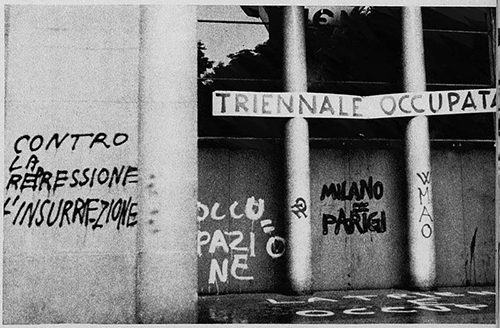
Occupation of the Triennale di Milano, 1968
[en]
Several strikes are situated in a hybrid zone between performance, aesthetic networking, protest and renewal of the contexts of artistic production. In general because, as Michael Hardt & Toni Negri remind us in their Assembly (2017), there is an artistic trait to the forms of protest that do not result in a material outcome.6 In other words, writes Judith Butler, because the proximity between uprising and artistic practices is underlines, in the regime of adhocracy, by the priority given to the simultaneous and silent presence of bodies in the public space over the verbalisation of demands.7 One is reminded of Ceremony for Freeway Fets (1978) by Senga Nengudi or of the performative cohabitation in November 2011 of the Occupy Wall Street movement at Zuccotti Park and at the Performa art biennial in the urban space of New York.8 Or, conversely, one can think of the forms of artistic strike and protest that take place by proxy through text, and renounce live performance by refusing at the same time the execution of an art work (Christopher D’Arcangelo, Lee Lozano, Gustav Metzger, Kai Althoff, Julien Prévieux).
The combination of politics and aesthetics in performance is at work also in Bakunin’s Barricades (2014), in which the artist Ahmet Öğüt proposes a museum-based reexamination of a protest strategy conceived by Mikhaïl Bakunin during the Dresden Revolution in 1849.9 The story, with the aura of the legend, was endorsed by Guy Debord in 1963: it is said that Bakunin proposed to sequester, at the State Art Collection Museum of Dresden, Raphael’s Sistine Madonna (1513-14) and place her on the barricades as a shield in order to block, by religious intimidation, the attack of the Prussian army.10 In 2014, at the Van Abbemuseum in Eindhoven, Öğüt constructed a barricade including a series of paintings drawn from the museum’s collection. The agreement between Öğüt and the institution is as follows: in case of complaints by civil society the museum would authorize the use of his work as a barricade in the public space as a support to the protests.
The performative dimension of the strike echoes in other encounters, between popular dramaturgy, procession, strike and counter-information. In 1913 in New York, two performative protest situations force the visibility of histories excluded from the public sphere and both take on the hybrid form of a procession and a performance. The first, The Star of Ethiopia, is organized by the writer W.E.B Du Bois between 22 and 31 October 1913 and is situated at the crossroads of theatrical performance and protest. Scripted as a monumental theater piece, Du Bois’ project aims to inscribe Afro-American history in an alternative constellation through the live incarnation of a counter-scheme. Just like many strikes at the time, his pageant raises the question of conditions of enslavement and Afro-American working conditions in the present. Thus, the performative form of the pageant connects to the strike through its purpose stated in demands and through the way it involves bodies in the public space. If W.E.B. Du Bois’ event gathered around 350 performers and 35’000 participants, the Paterson Pageant organized by Mabel Dodge Luhan and John Reed on 7 June of the same year brought together 1000 performers. Among them were many workers invited to play their own role on the stage at Madison Square Garden in order to transmit one-to-one their memories of strikes at the textile plants of Paterson, New Jersey. Later, around 1968, the occupation and destruction of the exhibition of the Milan Triennial dedicated to the ongoing student protests would raise the question of the coincidence of the mise-en-abime11 of the protest and its genuine impact. Is it possible to exhibit a protest, and under what circumstances can the performative gesture be relayed (or archived) in real time? When it comes to Occupy Wall Street, the Indignados Movement or the Arab Spring, the immediate production of archives and transmission are constitutive of the revolt itself and become, as such, performative gestures. When, as was the case during the 7th Berlin Biennial in 2012, the flux of images from the Occupy! demonstrations in Germany was exhibited live at KW [Kunst-Werke, Berlin] and on social media, the question of the distinction – or distance – between aesthetics and politics emerged in the exhibition logic of the museum. At least at first glance, since ultimately the invitation to Occupy! to show itself live in the spaces of an art center resembles – without coinciding with – the self-determination of the spontaneous occupation in protest.
6 Michael Hardt & Toni Negri, Assembly (Oxford: Oxford University Press, 2017).
7 Judith Butler, Notes Towards a Performative Theory of the Assembly (Cambridge: Harvard University Press, 2015) ; Zeynep Tufekci, Twitter and Tear Gas: The Power and Fragility of Networked Protest (New Haven : Yale University Press, 2017).
8 Léa Lescure, “Occupy Performa” (in French), Mouvement, 5 janvier 2012.
9Sven Lütticken, « Social Media: Practices of (In)Visibility in Contemporary Art », Afterall, 40, 2015.
10Guy Debord, The Situationists and the New Forms of Action in Politics and Art, original trilingual edition (Danish, French, English) Destruktion af RSG 6 Galerie EXI, Odense (Denmark), June 1963 <http://www.bopsecrets.org/SI/newforms.htm> (accessed 2017-09-17).
11 Mise-en-abime (French: mise-en-abyme or mise-en-abîme): self-reflection / image within an image / story within a story; from heraldry, where it designates the recursive depiction, within an escutcheon, of that same escutcheon.
Saturday, 28 October, 10:30h doors open, coffee / tea / croissants
11:00h Session 2 Performative (Un)Learning – Performance as Teaching with Donatella Bernardi, San Keller, Kamen Stoyanov, Axelle Stiefel, moderated by Bernadett Settele
12:50h lunch break
13:35h panel discussion
Donatella Bernardi

Carpet Pond, textiles (cotton, sequins and polyester), 240x240x27 cm, 2017, in collaboration with Laura Locher. Photo: Kilian Bannwart
I could have stayed all night long, sitting under the fan and discovering a new aspect of Brazil. But we had to move out of the poor little cabaret because of unexpected and unwelcome pepper powder that had been thrown in by the police to force everyone to evacuate. We were all out in the street now, coughing and crying. We then quickly left the Beco dos artistas and finally found a bus going in our hostel’s direction.
It’s not easy to understand exactly why I felt so welcome in that cabaret, why it was such a privilege for me to be a part of it, why I experienced so much relief in the presence of these people, why it gives me hope, why this September night in Salvador da Bahia was perhaps a turning point in my existence, and how important it was to share it with Giorgio. The first, easy answer would be to say that I felt accepted and automatically part of an experience. The second one might be the humour and derision that gives drag queens such sovereignty, whatever situation they find themselves in, sharing a sense of freedom and pride, even if they may be condemned to prostitution.
(excerpt from I got a manicure, 2012–2017)
San Keller

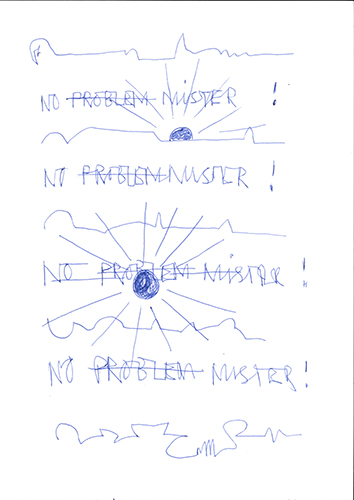
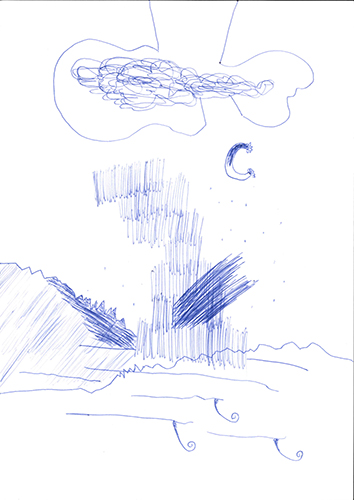
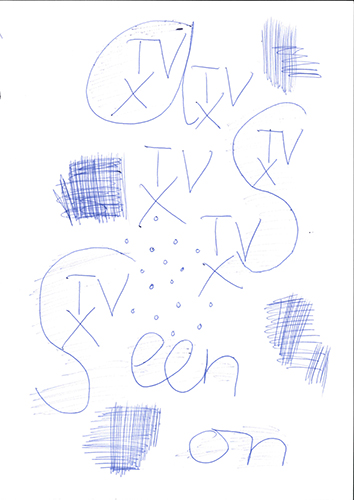
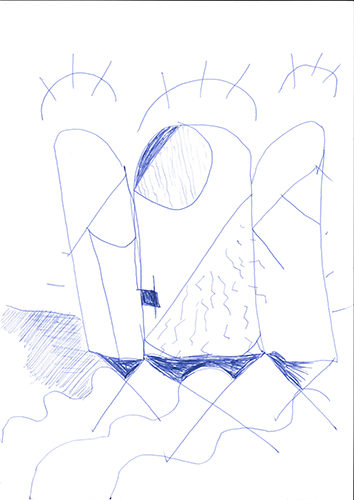
Kamen Stoyanov: Art Is a Weapon

Kamen Stoyanov, Art is a Weapon, 2017. Video still
Taking my performative work Art Is a Weapon (2017) as a starting point, I will explore the relationship of art and production, of art and distribution, and the role of the artist therein. Art becomes a “bullet”, a ping-pong between the artist and the audience. Hereby the artist plays the active part of this relationship, digging out the suppressed, and creating an uncanny feeling.
Axelle Stiefel
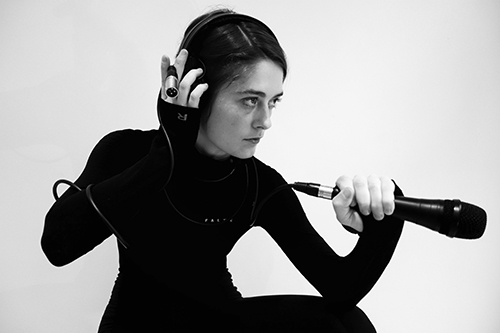
Axelle Stiefel, The Operator, 2016. Photo: Basic Publishing Strategy
[fr]
Il s’agit d’un texte à tendance hypnotique que je travaille depuis plusieurs années, à la manière d’un cut-up. Il est destiné à être lu par une voix amplifiée, rythmée par les bouffées intercalées d’une cigarette faisant office de tempo. Les paroles ainsi portées au micro formulent des propositions paradoxales qui agissent comme un facteur é-motionnel soit une incitation au mouvement chez celui qui le reçoit. On observe alors comment l’attention se déplace depuis le « performer » vers ce qui en nous, du dedans comme du dehors, nous fait bouger.
[en]
It is a text of hypnotic tendency that I have been working on for several years, in the manner of a cut-up. It is intended to be read by an amplified voice, punctuated by interspersed puffs from a cigarette that drive the tempo. The words thus carried to the mic formulate paradoxical positions that act as an e-motional factor or an incitement to movement in those who receive it. One then observes how attention is displaced from the performer to that which in us, both from inside and outside, makes us move.
Bernadett Settele: Performance (as) teaching

neulich in niederösterreich (23.4.2016). Photo: Anna Schürch
[de]
„Queer education displaces and decenters; queer curriculum is noncanonical, for starters.“ So leitete William Pinar hoffnungsvoll seinen Band zu Queer Education ein. Was hat das Nachdenken über die Performativität von „teaching“-Situationen mit Performance zu tun? Kann sich mit Performance zu beschäftigen das Bewusstsein für die Fallen des (ver)körper(geschlecht)lich(t)en Beisammenseins schärfen; eine Sensibilität dafür, was neben dem, was vorderhand der Gegenstand des Lehrens bzw. des Lernens ist, noch alles an Bildungsprozessen abläuft? Kann eine Kenntnis von Performance/s, ein Performance-teaching-Archiv helfen, Mechanismen der Körper- und Selbstbildung sowie des Eintretens in Beziehungen wirkungsvoll vorzuführen?
Wie ist die Offenheit von kollektiven ästhetischen Situationen – in Rezeption und Produktion – , wie sie Mira Sack etwa als wichtigen Faktor der Theaterpädagogik beschreibt, generell zu denken? Als das Selbst bildend, oder im besten Falle, feste Konzepte und Identifizierungen ent-bildend? Wie können die grossen drei, die Kernthemen des dekonstruktiven Feminismus – Materialisierung, Identifizierung, Relationalität/Orientierung – in und durch Performance, in Bildungssituationen, aufs Tapet kommen?

classroom trogen 2013. Photo: Alexandra D’Incau
[en]
“Queer education displaces and decenters; queer curriculum is noncanonical, for starters.” Thus William Pinar introduces in a hopeful tone a volume on Queer Education. What does reflecting on the performativity of teaching situations have to do with performance? Can dealing with performance sharpen our sense of the pitfalls of (em)bodied(-gendered) being-together? A sensitivity for what, besides what is ostensibly the object of teaching or learning, is going on in terms of educational processes? Can knowledge of performance/s, a performance-teaching archive, help effectively unmask the mechanisms of body- and self-formation and of entering into relations?
How is the openness of collective aesthetic situations – in reception and production –, described by Mira Sack among others as an important factor in theater pedagogy, to be thought? As an openness that forms, or, in the best case, also decenters the self, abolishing fixed concepts and identifications? How can the big three, key topics of deconstructive feminism – materialization, identification, relationality/orientation – be put center-stage in and through performance, in educational situations?
Katharina Swoboda: To Performen Muche Time
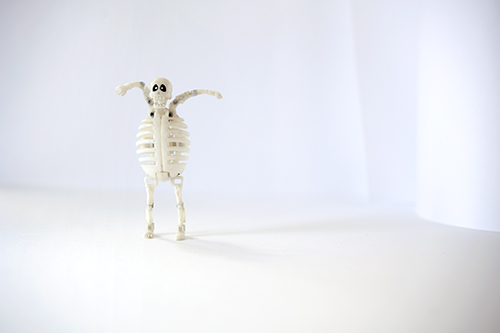
Katharina Swoboda, Woyzeck, 2017. Digital photography
[de]
Die Ursprünge des Worts Performance gehen auf das altfranzösische par (alles), fornir (anbieten) und forme (Form) zurück. In seiner ursprünglichen Bedeutung bezeichnete zu performen so etwas wie zu vollbringen oder zu vervollständigen. Diese Bedeutung steht in fast schon gegensätzlicher Beziehung zu den stark prozessualen Gesten heutiger Performancekunst, denn oftmals ist das Scheitern interessanter als High Performance (um einen Ausdruck der spätkapitalistischen Arbeitswelt zu gebrauchen). In ihrem Beitrag untersucht Katharina Swoboda das Vervollständigen und Abschließen performativer Akte im Sinne Judith Butlers. Das ständige Wiederholen dieser Akte formt Identität und das gesellschaftliche Subjekt. Aber was passiert mit dem (künstlerischen) Selbst (-verständnis), wenn die Performance nicht mehr im ständigen Werden begriffen ist, sondern viele Enden findet?
Die Performance geht vom Sprechapperat der Künstlerin aus, wird multimedial übersetzt und trifft auf die Körper der Besucher_innen.
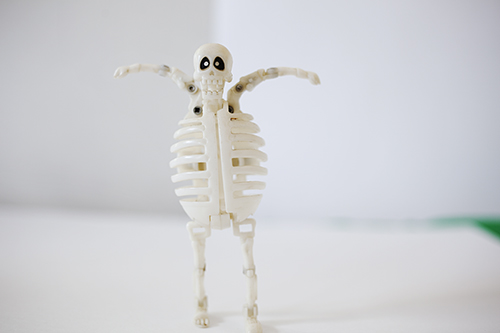
Katharina Swoboda, Woyzeck, 2017. Digital photography
[en]
The term performance goes back to Old French par (everything), fornir (offer) and forme (form). In its initial meaning, to perform designated something like to achieve, to fullfill or to complement. This meaning is in a quasi contrast to the pronouncedly processual gestures of today’s performance art, as failure is often more interesting than high performance (to use a term from the realm of late capitalist labor). In her contribution Katharina Swoboda examines the complementing and completion of performative acts in Judith Butler’s sense of the term. The continuous repetition of these acts forms an identity and a social subject. But what happens to the (artistic) self (-conception) when a performance is no longer in continuous becoming but has many endings?
The performance arises from the vocal tract of the artist, is multimedially translated and encounters the body of the visitors.
Kamen Stoyanov: Art Is a Weapon
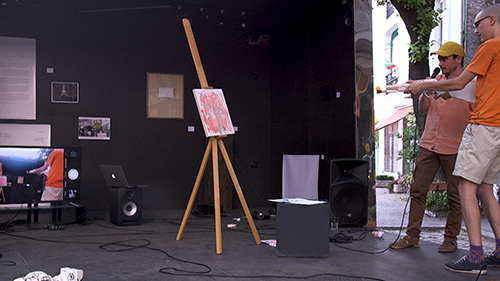
Kamen Stoyanov, Art is a Weapon, 2017. Video still
In the performance Art Is a Weapon, Kamen Stoyanov promotes art and painting production instead of the production of weapons. In 2015 and 2016 the production of weapons in Bulgaria grew by more than 100 percent, and weapons for more than 700 million euros have been exported mostly to countries in the middle east. Arsenal is the biggest weapon producer in Bulgaria. The factory is situated in the city of Kasanluk, which is also known as the main city in the rose valley in Bulgaria. Bulgaria produces over 20 percent of the rose oil in the world.
Kamen Stoyanov proclaimed Artenal instead of Arsenal. In the performance he insists that “Art is a good weapon”. First he painted a rose-target image, then he demonstrated the functioning of a ping pong ball gun made out of wood remains from his studio.
At the end he invited the audience to put an end to the painting by shooting at it. The best shot, as announced by the artist at the beginning of the performance, took the painting home.
16:15h Session 3 What’s Wrong with Performance Art – Strategies in the Performative with Valerian Maly, Voin de Voin, Camille Aleña, Lou Masduraud and Guillaume Pilet, moderated by Dimitrina Sevova
18:35h panel discussion
Valerian Maly

Valerian Maly, Performance Pinkel Pause, anlässlich L’origine contre la colère. Performance mit Angela Marzullo aka Makita, PPP Progr Performance Plattform, Bern, 2017
[de]
„Für all die wenigen“ – ein Bonmot von Norbert Klassen, der zu seinem "Publikums-Erwartungs-Management" (damals gab es diesen unsäglichen Begriff noch nicht) befragt wurde – bleibt für Valerian Maly als Festivalleiter, Performance-Künstler und als Dozent für Performance Art ein Leitmotiv. Die permanente Rückeroberung des Nutzlosen ist tägliche Herausforderung. In einer immer durchstrukturierteren, ökonomisierteren und letztlich auf Effizienz getrimmten kapitalistischen Welt stellen sich dringende Fragen, wo denn das nun aus dem Ruder gelaufen, ja schiefgelaufen ist mit der Verbindung von Kunst und Leben. Das sind letztlich unterschiedliche Dynamiken, die nicht vereinbar sind.
Nach und nach fühlt sich Valerian Maly als Mitglied eines zwar international vernetzten „tribes“ – das Performance Art Netzwerk – einem Stamm, der wohl bald unter „Minderheitenschutz“ gestellt werden muss. Braucht es Schutzzonen für Performance Art, braucht es Ruhezonen vor übergriffigen kuratorischen Konzepten?
Wohl fühlt sich Valerian Maly in Refugien, wie kürzlich im Kunstmuseum Winterthur und der Sammlung Oskar Reinhart, wo nebst hervorragender post-minimalistischer Kunst auch Faltenwürfe eines Gerard ter Borch, der Jüngere (1617 - 1681) oder Jean Siméon Chardins Stilleben mit Kristallgefäss, Pfirsichen und Trauben, um 1759, zu entdecken waren – zum auf die Knie fallen!
Als Performance-Künstler und Kurator für Performance Art gilt es auf Augenhöhe, aber schielend zu agieren, mit anderen Künstlern, mit dem Publikum, mit „all den wenigen“, die sich wirklich und vertieft für Phänomene der Performance Art interessieren. Auf dem linken Auge Künstler, auf dem rechten Auge Kurator und irgendwo im schielenden Kreuzungspunkt findet das eigentliche Ereignis, das Experiment statt: „Ds Lotti schilet, ds Lotti schilet, niemmer weis wos mit de Ouge häre zilet…“ (Mani Matter)

Valerian Maly, Performance Pinkel Pause, anlässlich L’origine contre la colère. Performance mit Angela Marzullo aka Makita, PPP Progr Performance Plattform, Bern, 2017
[en]
“For all the few” – a bon mot by Norbert Klassen who was asked about the management of the public’s expectations (at a time when this dreadful term did not exist yet) – remains a guiding theme for Valerian Maly as a festival director, performance artist and lecturer on performance art. The permanent reconquest of the useless is a daily challenge. The ever more structured, economicized capitalist world ultimately streamlined for efficiency raises urgent questions about where that relation between art and life has spiralled out of control, where it has gone wrong. These are, in the end, different dynamics that are not reconcilable.
Little by little, Valerian Maly feels as a member of an internationally networked tribe – the Performance Art network – a clan that will surely soon be put under the protection of minorities. Is there a need for a protection zone for performance art, or for rest area from invasive curatorial concepts?
Valerian Maly feels good in refuges such as recently at Kunstmuseum Winterthur and the Oskar Reinhart Collection, where beside superb post-minimalist art one could discover draperies by Gerard ter Borch the Younger (1617 - 1681) or Jean Siméon Chardin’s Still Life with a Basket of Peaches, White and Black Grapes with Cooler and Wineglass, around 1759 – enough to make you fall on your knees!
As a performance artist or curator for performance art one is to deal on equal footing [literally: at eye level] and yet cross-eyed with other artists, with the public, with “all the few” who are truly and deeply interested in the phenomena of performance art. An artist on the left eye, a curator on the right eye, and somewhere in the cross-eyed intersection the actual event, the experiment takes place: “Lottie crosses her eyes, Lottie crosses her eyes, no one knows where she takes aim with her eyes.” (Mani Matter; Swiss singer and songwriter who sang in Swiss German)
Voin de Voin

Voin de Voin, Living a dream in a mist of wars, 2017, Sofia. Photo: Marie Civikov
The general theme in my work is psycho geography. To visualize and perform an alternate mapping of land via an internal logic. My body has subconsciously become the axis point of the two geographical linear directions east and west – as a human compass. Born in the east, and having lived and worked in the west half of my life,those parameters have formed a meeting in my body, as an expression of two extreme approaches of living. Conflicts and ideology have often been of a controversial importance for me and has effected my work with its marks. It is expressed through a personal history (incorporating my practice in performance, installation, photography and video)
My work is about rules, restrictions, formats and their deconstructions. History appears always somehow different.
The necessity for restriction, and still the capacity to find freedom in new possibilities.
I am researching to establish a new form/aesthetic of the types of transformations my body goes through and states itself in different statuses, ofter expressed in political, sexual the body of meaning or the body of crises ,the absent body,a body of different manifestations and catharsis.
This metaphoric for “BODY” is often a physicality that manifests itself differently according to contexts.
My interest is to highlight the entangled complex web of relationships we live in by disrupting: East/West, Winner/Loser, Rules/Anarchy, Masculine/Feminine. In particular, the disaffection with the blurred border of centre.
Camille Aleña
There is a search for a thing, an image, a phenomenon: not a tradition but the memory of a tradition.
The components and principles of a ritual, the rehearsal of an ephemeral procession.
The images of a learning process witnessing people figuring out how to do something together, to get it right.
Learning experiences or experiments are captured.
If it just has happened it might as well happen again, in the same way, in a different place or a different way.
Lou Masduraud

Antoine Bellini & Lou Masduraud, Coil interior, 2017. Exhibition view, Hard Hat, Geneva. Photo: Quentin Lannes
[fr]
A partir d’une sélection de comportements populaires et d’objets trouvés dans un langage culturel commun (économique, technologique, social, médiatique...), nous créons des environnements qui engagent des relations ou révèlent des positions. Nous intervenons dans ces espaces en se tenant hors de la représentation, visant plutôt la création de situation et une forme de performativité partagée.
Lou Masduraud intègre des éléments quotidiens aux installations pour convoquer des relations d’usage pré-existantes afin d’en souligner la désuétude ou l’intensité, ou simplement d’en déplacer légèrement l’expérience. Antoine Bellini compose les bandes sonores des installations et des situations en entremêlant les codes de compositions de musiques populaires et engage ainsi également nos habitudes d’écoutes, à la fois personnelles et collectives. A l’écart de la critique sociologique, nous essayons de produire des environnements qui reflètent un certain état du monde, puis de les modeler et d’y intervenir afin de questionner nos positions, nos directions, nos forces d’action, notre liberté et notre identité au sein de situations collectives.

Antoine Bellini & Lou Masduraud, Coil interior, 2017. Exhibition view, Hard Hat, Geneva. Photo: Quentin Lannes
[en]
On the basis of a selection of popular behaviors and of objects found in a common cultural language (economic, technological, social, mediatic, …) we create environments that engage relationships or reveal positions. We intervene in these spaces, keeping outside representation, aiming rather to create a situation and a form of shared performativity.
Lou Masduraud integrates elements of day-to-day life into the installations in order to evoke preexisting relations of use to underline their obsolescence or intensity, or simply to shift ever so slightly the way they are experienced. Antoine Bellini composes the soundtracks of the installations and situations and engages also with our listening habits, both personal and collective. Outside of sociological critique we aim to produce environments that reflect a certain state of the world, and modulate them and intervene in them in order to put into question our positions, our directions, our forces of action, our liberty and our identity in collective situations.
Guillaume Pilet
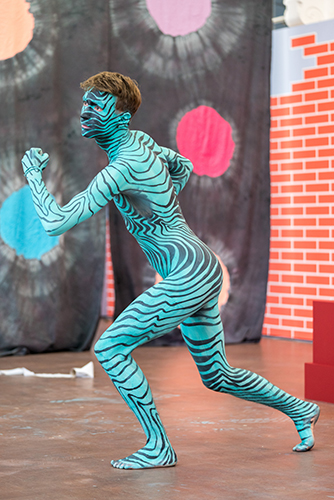
Guillaume Pilet, Dream a little Drama, Primary, Nottingham, 2017. Photo: Reece Straw
Pilet’s redolent objects – his apples, pumpkin, paints and mummified body – have autobiographical values that are not immediately known to us but become vaguely apparent through epicurean animation. They perform like the accumulated ‘treasures’ of childhood defined by the writer Roger Callois as ‘coin of another realm’. In this instance, their currency is an absurd capacity for the invocation of peculiar sensualities, ones that we inevitably empathically experience as we watch their strange dramaturgy unfold. These objects hold weight in the space circumscribed by the performance just as potently as the performer does, because according to the artist’s playful illogic, this space is one that holds open the childlike expectation of animism; the belief that all matter possesses a living spirit. Don’t believe me? Watch out for the pumpkin that positively smokes with embarrassment when its naked form is described in paint, or check out your own anxious anticipation of that mummy finally coming to life through some diabolical practice of reanimation! Pilet’s performer is a trickster, and as the visionary anthropologist Michael Taussig has written, the trick ‘seduces and cajoles’, it ‘knows and enjoys the leap beyond the thingness of things’.
– Jamie Sutcliffe about Dream a little Drama, Primary, Nottingham, 2017
Dimitrina Sevova: Performative (infra-)structures. The Embodied, Performance and Non-Verbal Gestures
Further information forthcoming
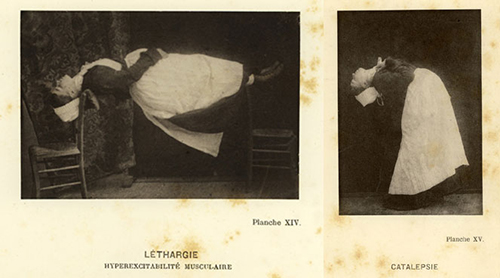
Dr. Jean-Martin Charcot and the Theater of Medicine, an online exhibition of the Waring Historical Library, Medical University of South Carolina Library. Charleston, SC: Waring Historical Library, 2006.
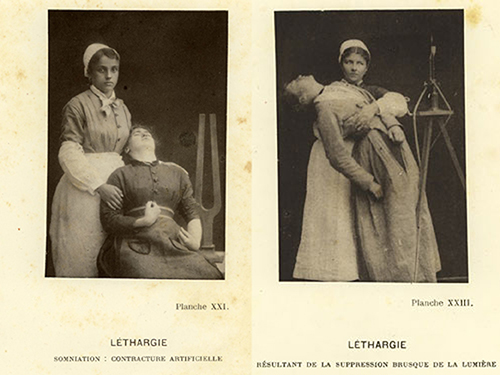
Dr. Jean-Martin Charcot and the Theater of Medicine, an online exhibition of the Waring Historical Library, Medical University of South Carolina Library. Charleston, SC: Waring Historical Library, 2006.

Dr. Jean-Martin Charcot and the Theater of Medicine, an online exhibition of the Waring Historical Library, Medical University of South Carolina Library. Charleston, SC: Waring Historical Library, 2006.
Camille Aleña
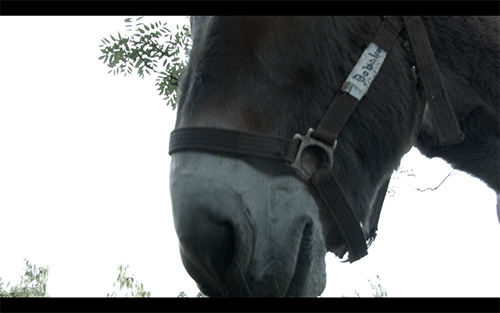
Camille Aleña, 2017. Video still
[fr]
Il s’agira au travers de cette performance de réaliser un arrêt sur image, une sorte de preview d’un projet qui sera présenté au Wallriss en avril 2018. Ce travail suit l’évolution d’une tradition vieille de plus de 100 ans à Fribourg, ville natale de l’artiste; la Saint-Nicolas. Reformuler des nouvelles constellations, des nouveaux sens quant à l’opposition politique entre traditionalisme et conservatisme en se servant des éléments contextuels existants et des écosystèmes sociaux locaux, telle est l’ambition de ce projet. La performance présentera un aperçu d’une production qui s’affranchira de la fiction et du documentaire – indétermination du genre – avec la présence de certains protagonistes en personnes ou présent par le moyen de la technologie (skype par exemple).
[en]
The aim is, through this performance, to realize a freeze frame, a sort of preview of a project that will be presented at Wallriss in April 2018. This work follows the evolution of a tradition of more than 100 years in Fribourg, the native city of the artist, Saint Nicholas. Reformulating new constellations, new meanings with respect to the political political division between traditionalism and conservatism, making use of existing contextual elements and local social ecosystems, thus the endeavor of this project. The performance will present a glimpse on a production that will do away with fiction and documentary – an indetermination of genres – in the presence in person of certain protagonists, or their presence by means of technology (such as Skype).
Delphine Chapuis Schmitz: (Re)collections – eine Auswahl
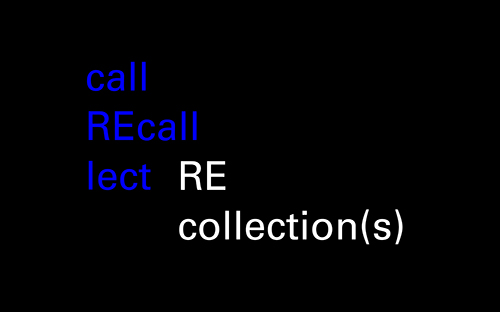
A series of pieces I have either experienced, heard, or read about, will be remembered as what might be happening right now. Some say gestures have to be forgotten so that they can be done again – and so I’ve forgotten everything, and so we’re forgetting everything, every small part of the past – resolutely delegating our present memories to bits and pieces no one is in a position to make sense of anymore. Will somebody someday be able to recollect the morsels? Don’t we rather want to start re-inventing viable alternatives in our present time? In this performative reading, I will unfold a possible narrative looking forward at what has been.
Sunday, 29 October, 10:30h doors open, coffee / tea / croissants
11:00h Session 4 Performance Szenen / Scenes – Tribal & Translocal Networking with Milenko Lazic, Pascal Schwaighofer, Muda Mathis and Gilles Furtwängler, moderated by Chris Regn
12:50h lunch break
13:50h panel discussion
Milenko Lazic
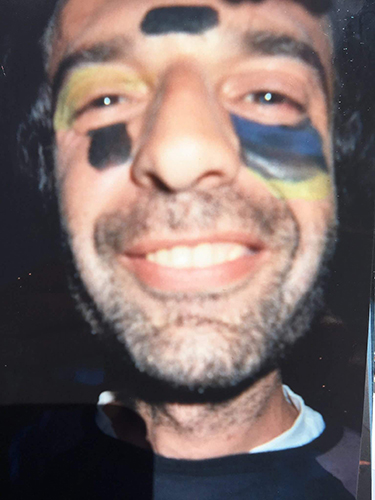
Im Anhang, fotografiert von Tilde Von Overbeck
[de]
Es ist Mittagszeit in Zürich. Vor mir auf dem Trottoir ca 3, 4 Meter entfernt zwei Männer in Anzügen. Ich nehme an, sie arbeiten in einer Bank. Ich kann kaum verstehen, was sie besprechen. Ihr Dialog ist laut und emotional. Bla bla bla bla Performance bla bla bla bla Performance bla bla super Vision bla bla bla bla Performance bla bla Performance bla bla super Vision bla bla bla Performance bla bla bla bla. Ich beeile meine Schritte, um besser zu verstehen, was für abgespacete super Visionen diese Performer vorhaben.
[en]
It is lunchtime in Zurich. In front of me on the sidewalk, three or four meters from me, two men in suits. I assume they work in a bank. I can hardly understand what they are discussing. Their dialog is loud and emotional. Bla bla bla bla performance bla bla bla bla performance bla bla super vision bla bla bla bla performance bla bla performance bla bla super vision bla bla bla performance bla bla bla bla. I press my steps in an effort to understand better what kind of delirious super vision these performers may have.
Pascal Schwaighofer
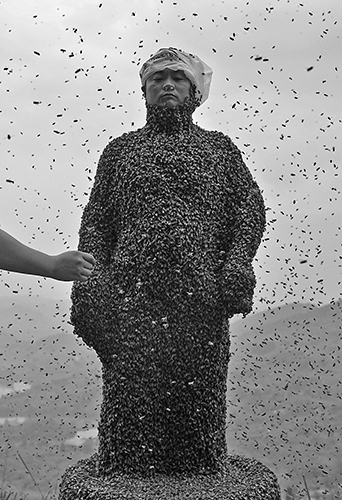
Beekeeper She Ping (AFP/Getty Images)
Metaphors appear to be comfortable and comforting assistances that enable us to think ourselves differently, take a few steps back, and avoid collusion with reality. However if it’s true—as many scholars argue—that we are constantly speaking and acting (solely) through the intermediation of analogies, metaphors and paradigms, how shall we describe the “scene” of which we are part? What is the most natural and meaningful conveyor that would portray a network that inscribes the observer him/herself? And what if the “performance” that we wish to talk about is already a metaphor for something of which we haven’t yet figured out what it is?
Muda Mathis: Das Unreine und die Opulenz
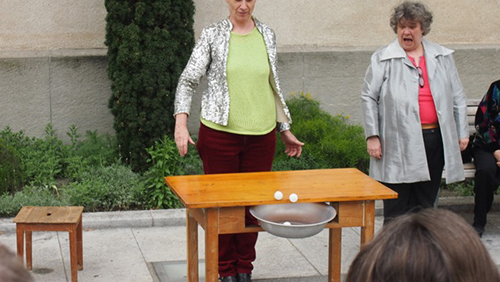
Muda Mathis, Sus Zwick, Chur durchwühlen, 2010. Photo: Peter Trachsel
[de]
Wie wir alle wissen Performance ist: Zeigen, Teilen, Teilen des Momentes, Anwesenheit, Anwesenheit aller Anwesenden; Akteure, Voyeure, Publikum, Elefanten, Passanten.
Als Publikum habe ich für Performerinnen und Performer jede Menge Zuschreibungen:
Bands sind Gangs, die auf kollektive Intelligenz und Genialität vertrauen.
Grotesken sind grotesk oft anrührend und markant.
Priester sind Priester und Körper gibt's deren viele.
Es gibt auch Zeitdehner, die Einen langweilen, die Andern halten die Spannung - das gefällt dann allen.
Es gibt Flüchtige, Unsichtbare, Stumme, wissenschaftlich Recherchierende, Zitierende, Physiker, weil Physik schöner ist wie jede Religion. Natur, Material, Geste, Spaziergänge, Zahlen und Systeme, medienbasiert proijeziert, die Welt der konkreten Dinge, Stapelweise A4 Papier.
Es gibt Literaten und Poeten, Szenenmischer und Planvollstrecker vollziehen ihren Plan.
Gnade den Konzepten die nur sich selbst erfüllen.
Gnade den Konzepten die nur sich selbst erfüllen.
Versucher die es versuchen. Die Nackten und die Didakten glauben an Kommunikation und dass die Erzählung dem Abstrakten die Zähne nimmt.
Und dann gibt es die Pseudo-Didakten die Verwirrung stiften, um Platz für Interpretation zu schaffen.
Wir alle wissen: Performance ist handeln, ist sprechen, ist live, ist Autorschaft.
Performance ist schmutzig - ist gar nicht rein - ist nie allein.
Körper ist nicht abstrakt spricht immer auch von Geschlecht und Alter und Zugehörigkeit.
Performance ist gross.
Performance ist gross und nie alleine.
Performance ist Mode und Mode ist nicht beständig.
Performance als Begriff ist flüssig. Jetzt auf jeden Fall, grade jetzt - ist der Begriff flüssig, das finde ich gut.
Performance als Begriff ist inflationär und das macht die Sache nicht einfacher - macht nichts.
Performance kommt aus vielen Ecken, hat viele Interessen,
Performance ist gross und in aller Munde.
Performance konstruiert Dynamik.
Wiederholen bis es wahr ist, Wiederholen bis es wahr ist, Wiederholen bis es wahr ist.
Performance ist gross. Das Performative kann in alle Systeme hinein dringen, sich hinein fühlen hinein fingerln.
Performance kann ganze Systeme als Räume begreifen, als Bühne, als Gegenüber als Untersuchungsgegenstand, als Ort der Subversion, als Ort der Kontemplation.
Es tut gut zu wissen in welchem Raum man sich befindet.
Es ist gut zu wissen in welchem Raum man ist, um die Bedingtheiten des Selben für die eigene Sache zu aktivieren.
Doch - Performance Kunst ist klein, ist marginalisiert, ist eine Lachnummer, ist am Rande, ist Subkultur, ist Experiment, Avantgarde - "ha" eine Lachnummer, ist nicht richtiges Theater, ist schreckliche Musik, ist dilettantisches Gewusel, ist unfreiwillig lustig, ist Fremdscham, ist anstrengend.
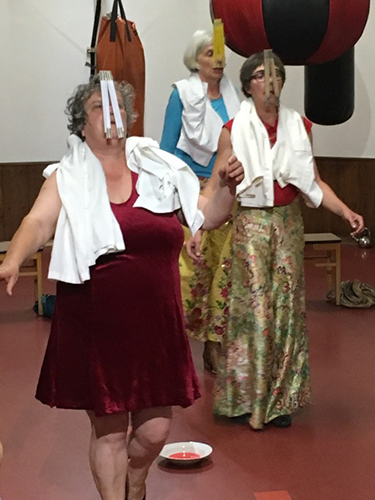
Muda Mathis, Sibylle Hauert, Sus Zwick, Fur of Fear, Boxclub Basel, 2017. Photo: Axel Gampp
Performance schöpft aus den verschiedensten Traditionen:
Musik, Tanz, Theater, Literatur, Film und natürlich aus der bildenden Kunst.
Aus der bildenden Kunst da komme ich her, da weiss ich Bescheid,
und ich sage euch:
Ohne Konzept, ohne Konzeptkunst hätte sich die Performance Kunst nie entwickeln können.
Ohne Konzept, ohne Konzeptkunst hätte sich die Performance Kunst nie entwickeln können.
Das Performative in der Kunst wäre eine Episode geblieben. Das Problem Performance gäbe es gar nicht.
Die Theaterleute würden Theater machen, Tanz den Tänzerinnen und Tänzern, Musik von U- bis E- virtuos!
Und die Künstlerinnen würden malen und nicht denken: Der Gedanke allein kann Kunstwerk sein. Handlung alleine kann Kunst sein.
Make a salad, sagt Alison Knowles, und da ist er – der Salat.
Text performt anlässlich von ACT ON, der Jubiläumsveranstaltung von ACT, dem interschulischen Performance Festival der Kunsthochschulen der Schweiz, am 27. 9.2013 in der Kaserne Basel.
Song von Muda Mathis mit Inka Palme (Sarina Scheidegger, Chantal Küng, Nora Locher)
weitere Mitwirkende Birgit Kempker, Jörg Wiesel, Gregory Hari
[en]
As we all know, performance is: show, share, share the moment, presence, presence of all present; actors, voyeurs, public, wiseguy, passers-by.
As a public I have all sorts of attributions for performers:
Bands are gangs that trust collective intelligence and genius.
Grotesques often are grotesque touching and striking.
Priests are priests and bodies there are many.
There are also time-stretchers, some boring, and others hold up the tension - that is a pleasure for all.
There are volatiles, invisibles, mutes, scientific researchers, quoters, physicists, because physics is more beautiful than any religion. Nature, material, gesture, walks, figures and systems, projected media-based, the world of concrete things, piles of A4 paper.
There are literati and poets, scene mixers and plan executors executing their plan.
Have mercy with the concepts that only fulfill themselves.
Have mercy with the concepts that only fulfill themselves.
Tempters who attempt. The leechers and the teachers believe in communication and that the narrative unravels the abstract.
And then there are the pseudo-didacts who cause confusion in order to make space for interpretation.
We all know: Performance is taking action, is speaking, is live, is authorship.
Performance is dirty - is nothing at all - is never alone.
The body is not abstract speaks always also of gender and age and belonging.
Performance is big.
Performance is big and never alone.
Performance is fashion and fashion is not persistent.
Performance as a concept is liquid. Now, in any case, especially now - the concept is liquid, I like that.
Performance as a term is inflationary and that doesn't make things any easier - so what.
Performance comes from many quarters, has many interests;
Performance is big and a hot topic.
Performance constructs dynamics.
Repeat until it becomes true, repeat until it becomes true, repeat until it becomes true.
Performance is big. The performative can penetrate all systems, empathize its way finger its way in.
Performance can conceive of entire systems as spaces, as a stage, as a vis-à-vis as object of investigation, as a place of subversion, a place of contemplation.
It is good to know in what space one is.
It is good to know in what space one is, in order to activate the latter's conditionality for one's own purpose.
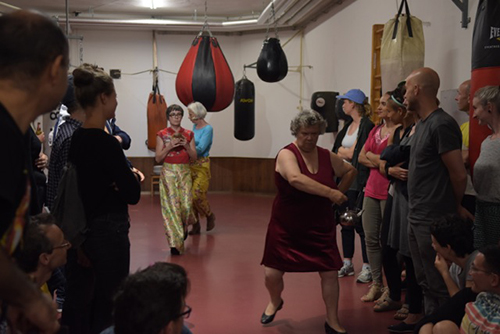
Muda Mathis, Sibylle Hauert, Sus Zwick, Fur of Fear, Boxclub Basel, 2017. Photo: Axel Gampp
Yet - performance art is small, margnialized, is a laughingstock, on the brink, is subculture, an experiment, avantgarde - "ha" is a laughingstock, is not real theater, is aweful music, is dilletante milling mass, is funny without intending to be, is surrogate shame, is strenuous.
Performance draws on the most varied traditions:
From music, dance, literature, film and of course visual art.
From visual art to earth I come, I know my way around it,
and I tell you:
Without a concept, without concept art, performance art could never have developed.
Without a concept, without concept art, performance art could never have developed.
The performative in art would have remained a side note. We would not have the question of performance.
The theater people would be doing theater, dance to the dancers, music from U to E virtuoso!
And the artists would paint and not think: The thought alone can be art work. Action alone can be art.
Make a salad, says Alison Knowles, and here it is – the salad.
Text performed on the occasion of ACT ON, the anniversary event of ACT, the interschool performance festival of the Swiss art universities, on 27.09.2013 at Kaserne Basel.
Song by Muda Mathis with Inka Palme (Sarina Scheidegger, Chantal Küng, Nora Locher)
also performing, Birgit Kempker, Jörg Wiesel, Gregory Hari
Gilles Furtwängler
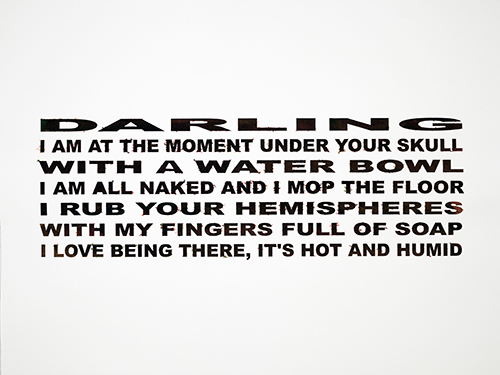
[fr]
Cela commence par une adresse directe aux spectateurs, suivi par des interpellations, des questions, des injonctions, des vérités, des chuchotements, de la morale, des contre-vérités, de l’ironie, de l’hypocrisie, du cynisme, de l’absurdité et des contradictions.
Attraper les spectateurs en leur parlant d’amour, d’abstraction et de paysage, les retenir avec des concepts, de la sexualité, de la morale, de la politique, les laisser partir avec des pulsions, des privilèges, du quotidien.
T’es content de ta tablette? Tu peux imprimer depuis ta tablette? Et depuis ton téléphone, tu peux imprimer? L’objectif de l’appareil photo, il est ok? Qu’est-ce qu’il se passe? T’es content de ton gmail?
Je voulais te dire que tes mots doux sur le frigidaire remplissent mon coeur de joie.
Comme le fait que j’aime, que j’adore voir tes chaussettes dépasser de la valise.
Et encore que je ne me lasserai jamais de te regarder écouter la radio le matin.
[en]
It starts out with directly addressing the spectators, followed by interpellations, questions, injunctions, truths, whispers, moral, falsehoods, irony, hypocrisy, cynicism, absurdity and contradictions.
Catching the spectators by telling them about love, abstraction and landscape, keeping them with concepts, sexuality, moral, politics, letting them go with pulsions, privileges, the everyday.
Are you happy with your tablet? Can you print from your tablet? And from your phone, can you print? The lens of your photo camera, is it ok? What is happening? Are you happy with your gmail?
I wanted to tell you that your sweet words on the fridge fill my heart with joy.
Just like the fact that I love, that I adore your socks sticking out of your suitcase.
And this, too: that I will never tire of watching you listening to the radio in the morning.
Chris Regn
Seit ich Muda Mathis kenne mache ich auch Performance in der Kunst und nicht wie vorher nur in subkulturellen und politischen Zusammenhängen. Sogar in meiner Meisterschülerzeit an der Kunsthochschule habe ich eine Performanceklasse gemacht, die die gemeinsamen Räume genutzt hat und die für das Gemeinsame und Autonome wirklich erhellend war.
Für mich ist es immer und jetzt neu mit dem PerformanceNetzwerk PANCH wirklich interessant. wie Begriff und Praxis sich in jedem Feld und jeder Region neu ausformulieren können und auch wollen. Wir können Raum herstellen und begehen und immer wieder gespannt sein. Viva: Treffen wir uns in der Performance!
Dorothea Schürch: Articulate! Small Inner Spaces
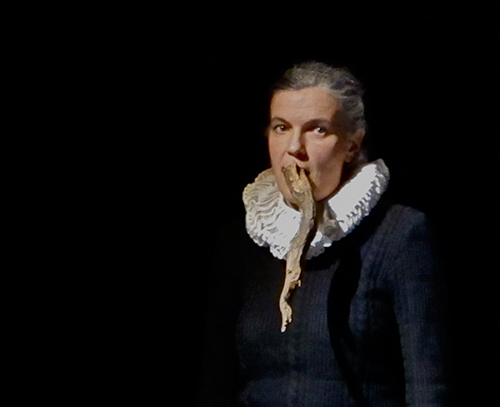
Dorothea Schürch. Photo: Cornelia Cottiati
[de]
Mit Articulate! Small Inner Spaces führt eine Verzweigung von What’s Wrong with Performance Art? zurück ins 16./17. Jahrhundert. Articulate! Vom Wirkungsvermögen des Sagens als ein Tun in Anlehnung an kabbalistische Praktiken. Das Sprechen selbst gerät in den Fokus, jeder Buchstabe zählt, jeder Buchstabe ein Ereignis. Die Artikulation geht von fünf Stellen im Mund aus, an denen die Sprechlaute, das heisst die einzelnen Konsonanten verankert sind. Dort sind sie, so die Vorstellung der Kabbalisten, mit Ketten zu einem oberen, göttlichen Mund verbunden worden. Jedes Sprechen ist ein zweifaches Sprechen, gleichzeitig mit einem unteren Mund und einem oberen Mund. Die kabbalistischen Ketten sind längst durchgetrennt – die Verankerungen des Sprechens sind aber heute noch vorhanden: eine Performance für Zunge und Ansatzrohr.
![Franciscus Mercurius van Helmont (1664 – 1699): Kurtzer Entwurff des Eigentlichen Natur-Alphabets der Heiligen Sprache : Nach dessen Anleitung man auch Taubgebohrne verstehend und redend machen kan / F. M. B. V. Hellmont. - [Online-Ausg.]. - Sultzbach : Lichtenthaler, 1667. Bild: © Herzog August Bibliothek http://diglib.hab.de/drucke/xb-4496/start.htm](img/sympodium/dorothea-schuerch/Franciscus-Mercurius-van-Helmont-m.jpg)
Franciscus Mercurius van Helmont (1664 – 1699): Kurtzer Entwurff des Eigentlichen Natur-Alphabets der Heiligen Sprache : Nach dessen Anleitung man auch Taubgebohrne verstehend und redend machen kan / F. M. B. V. Hellmont. – [Online-Ausg.]. – Sultzbach : Lichtenthaler, 1667. Bild: © Herzog August Bibliothek http://diglib.hab.de/drucke/xb-4496/start.htm
[de]
With Articulate! Small Inner Spaces a bifurcation of What’s Wrong with Performance Art goes back into 16th/17th century. Articulate! On the impact of saying as doing following cabbalist practices. The focus shifts onto speaking as such; every letter counts; every letter is an event. Articulation starts off in five places in the mouth where the speech sounds, i.e., the different consonants, are anchored. There, in the conception of the cabbalists, they have been linked together with chains to an upper, godly mouth. Every speaking is a dual speaking, simultaneously with the lower mouth and the upper mouth. The cabbalistic chains have long been severed – the anchorings of speech however are still there today: a performance for tongue and vocal tract.
Voin de Voin: Whatever happened to baby Voin #tag me tag me
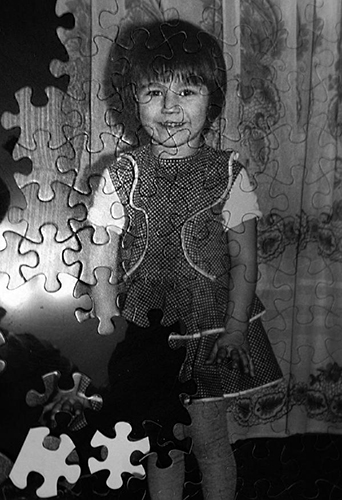
Voin de Voin, archive photo, 1982, Sofia … now made into a puzzle. Photo: mother, father or uncle
Looking at types of collective identities, entrenched in lifestyle and moral choices. These populist identities provide simple answers to complex processes. It creates an object-orientated democracy where vast systems of things are objectified and lose their relation to other things. Thus, the strategy to confront populism is via a disruption of objects (symbols) that comprise form having to make sure things do not appear timeless, fixed and immutable.
I explore different methods and ways to communicate to the viewer or an audience, often deconstructing existing formats like plays, librettos, photo stories, questionnaires, games, separations and instructions, Using familiar things to bring new meanings and open up a field where the mental process is revealed.
I see a possibility to get closely rethink the idea of unity and the meaning of the common consciousness. To draw out ideas of why this processes of organization of societies often fails.
What is the meaning of freedom both in the individual and the collective?
16:30h Session 5 Performative Tactics, Activism & Performance Politics with Mo Diener, Lia García, Angela Marzullo, Nathalie Rebholz, moderated by Denis Pernet
18:30h panel discussion
Mo Diener
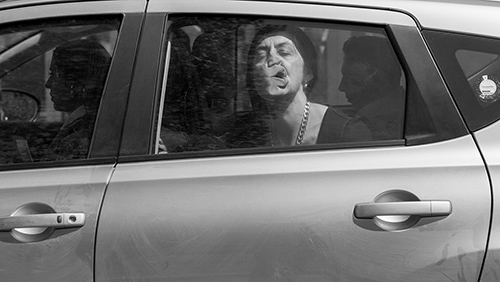
Roma Jam Session art Kollektiv – Mo Diener, R R Marki, Eva Merkling - Mihok, Milena Petrovic, what is the color of your car – savi farba se tu vurdon. Zürich 2014
[de]
In meiner künstlerischen Praxis als Performerin, sowie seit 2013 als künstlerische Leiterin und Kuratorin des Roma Jam Session art Kollektivs setze ich mich intensiv mit dem Körper und der Sprache der Performer auseinander. Die gemeinsamen Bewegungen in der Public Performance Detox Dance beinhaltet keine choreografische Ornamentierung (inspiriert durch Martial Arts Formen und Roma Tänzen), sondern sie kreiert Bilder des Zusammenfindens und Austauschens, der Gemeinsamkeit und des Spiels in einem Netzwerk. Mit dem Körper und „Mind as a Muscle“ (Yvonne Rainer) schafft das Projekt Detox Dance intrinsische Momente in einer „demokratischen Choreografie“. Die Erarbeitung von Detox Dance hat 2016 begonnen und hat sich seither als „Becoming a liquid Body“ zu einem Public Workshop gewandelt, der in der Praxis des Gemeinsamen und des demokratischen Prozesses Grenzen verflüssigt und Detox Dance zu einer Liquid Urban Sculpture werden lässt.
[en]
In my artistic practice as a performer, as well as since 2013 as the artistic director and curator of the Roma Jam Session art collective I have worked extensively with the body and language of performers. The common movements in the public performance Detox Dance involve no choreographic ornaments (inspired as it is by martial arts forms and Roma dances) but creates images of coming together and exchange, of commonality and playing with a network. With the body and “the mind as a muscle” (Yvonne Rainer), the project Detox Dance creates intrinsic movements of a democratic choreography. The elaboration of Detox Dance started in 2016 and has since mutated to a public workshop, Becoming a Liquid Body, which dissolves boundaries in the practice of the common and in democratic processes and turns Detox Dance into a Liquid Urban Structure.
Lia García: Trans Experience as a Pedagogic-Affective Performance (Affects as a political and educational space)
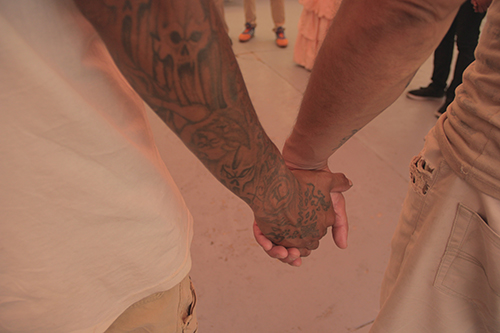
Lia García. Photo: Ian Derek Alexander Rivas, 2016, México City
In this presentation, I aim to share key aspects of Proyecto 10Bis, a collective pedagogical project that I led with 10 men who currently inhabit Reclusorio Norte, a male prison in Mexico City. In such pedagogical space, we work with affect as a political strategy for transformation, reflecting on masculinity and violence through pedagogic performances where the close contact of our bodies and personal histories is essential. My experience as a transgender woman has aroused both intimacy and fear, and there is where our continuous intervention plays a key role, stimulating a collective transformation. Proyecto 10Bis, as a continuous process, challenges the ephemeral character of performance art, and enters into dialogue with radical pedagogy and love, understood as political tools with the potential of deconstructing prison and the socially built tensions in the relation between men and trans women.
Angela Marzullo
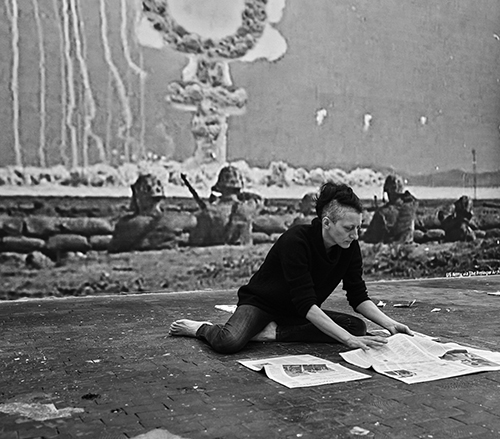
Angela Marzullo, Feminist Energy Crisis, Centre de la photographie Genève, 2017. Photo: Sandra Pointet
[fr]
La performance que je compte présenter dans le cadre de What’s Wrong with Performance Art? est une actualisation / déclinaison de la pièce L’Origine. Ce travail a été initié début 2017 au Centre de la Photographie Genève, durant les 28 premiers jours de l’exposition Angela Marzullo – Feminist Energy Crisis (27.01 - 12.03.2017).
Le protocole est le suivant : Munie de 4 exemplaires du journal Le Monde du jour et d’une paire de ciseaux, je choisis un emplacement dans l’espace, dispose le matériel sur le sol, et entreprends de découper consciencieusement un réseau de lamelles de papier au centre des publications. L’intervention tient de l’activité intime, studieuse et dure généralement 15 minutes. Elle requiert un travail de précision et de concentration que le public peut observer dans sa totalité ou de manière partielle. Cet équilibre entre intime et public est au cœur de ma démarche.
L’assemblage final consiste en un exemplaire recomposé du Monde, posé ouvert en son milieu sur le sol, avec en son centre une masse volumineuse formée par les franges de papier déchiqueté, faisant allusion, entre autres, au sexe féminin. L’Origine du titre prend, face à ce Monde revisité, une signification particulière, faisant échos au tableau de Gustave Courbet qui fit scandale à son époque.
Après avoir développé cette pièce de manière sérielle sur la durée (28 jours) et ancrée dans un lieu d’exposition unique (CPG), il me semble cohérent à ce stade de décliner ce processus de création dans un cadre mobile/nomade, site specific, et de le mettre à l’épreuve de publics et de contextes différents, ce en vue de lui donner une nouvelle ampleur, d’étendre l’exploration vers de nouveaux horizons.
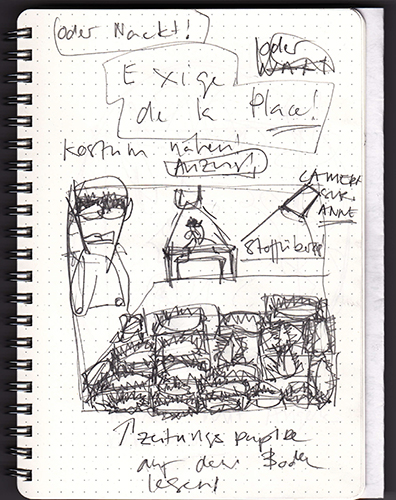
Angela Marzullo, Makita L’Origine, Los Angeles, 2016. Notes for the performance
[en]
The performance I shall present in the context of What’s Wrong with Performance Art? is an actualization / declension of the piece L’Origine. This work was initiated at the beginning of 2017 at the Centre de la Photographie Genève during the first 28 days of the exhibition Angela Marzullo – Feminist Energy Crisis (27.01 - 12.03.2017).
The protocol is as follows: With four copies of the newspaper Le Monde, issue of the day, and a pair of scissors at hand, I choose a spot in the space, place the material on the floor, and begin cutting up diligently a network of paper strips in the middle of the publications. The intervention has something of an intimate, studious activity, and generally lasts 15 minutes. It requires precision work and concentration, which the public can observe in its entirety or partially. This balance between the intimate and the public is at the heart of my approach.
The final assemblage consists in a recomposed issue of Le Monde, laid down on the floor open in its middle, with at its center a voluminous mass formed by the shredded paper fringes, alluding, among other things, to female genitalia. L’Origine in the title, in view of this revisited Le Monde, takes on a particular meaning, echoing Gustave Courbet’s painting that created a scandal in its time.
After having developed this piece in a serial manner over the duration (28 days) and anchored it in a unique exhibition space (CPG), it seems coherent to me at this stage to decline the creation process in a mobile/nomad context, site specifically, and put it to the test of different publics and contexts, in order to give it a new scale and extend the exploration towards new horizons.
Nathalie Rebholz
<obscene-micelium.jpg>
Denis Pernet

Guillaume Pilet, La Mesure Harmonique, 2015. Performed by Maximilian Fafetine in Alpina Huus, Schinkel Pavillon. Photo Jason Harrell
The practice of exhibition making needs politics, theory, architectures, actions, art practices, dance and music, memory and anticipation, movements and bodies, participants and collective experience. Can this juxtaposition lead to the transformation of the medium? Art practices are able to build counter-monuments, interventionist, discursive and “performative” actions. The public enters the action and takes part in the process, by viewing it, hearing it, seating, standing, moving, with its full body in action, talking or whistling. Theory has named it embodied spectatorship. Exhibitions, in contrast with books, hold the possibility of the moving body, the revolted body, the exhausted body (books may too, in a different way). The pinnacle is the guided tour, the curator’s performative action with the public. It is mediation degree zero and performance degree zero, as I have learned with Andrea Fraser and Martha Rosler. I tried more: as the curator of a group exhibition, I interpreted for the public Bach Whistle (1970) by Adrian Piper, a 44 minute long sound performance. I didn’t do it for the reenactment, but as a statement that a curator talks, sings, dances and, at time, whistles.
Gilles Furtwängler

Are you happy with your tablet? Can you print from your tablet? And from your phone, can you print? Your camera, is it ok? What’s happening? Are you happy with you gmail?
I wanted to say to you that your sweet words on the fridge fill my heart with joy.
Like the fact that I love to see your socks out of your suitcase.
And also that I never get tired of watching you listening to the radio in the morning.
Axelle Stiefel
My work is cinematic and performative. When the exhibition is not the medium itself, I use my own voice – amplified – as another channel to address the forces of production at stake in a moment of attention. Language is a primary material. Voice is the point of singularization of meaning. Machines are the vehicles. A matter of tuning.
Andrea Saemann

Andrea Saemann, Instant Camera in Forest, 7.5.2017. Performance with Anna Ostaszewska as translator, Present Performance Festival, Gdansk/Polen. Photo: Gisela Hochuli
[de]
Ich entwickle Performances alleine, zu zweit, im Kollektiv und zeige sie an Performance-Anlässen und in Performance-Festivals. Ich rede gerne in Situationen hinein. Ich recherchiere und performe Recherchen wie Gedankengebäude und Architekturen. Dies führt zum Performen und Kuratieren von Anlässen, zur Diskussion und Verfügung-Stellung der eigenen Zuschauerinnenperspektive.
Sehen. Mit der Performance im Raum sein und dann. Dabei gewesen sein und dann. Unmittelbar danach und sofort: schreiben. Die Gedanken, die Bewegungen, die Ausflüge, die Abwesenheiten.
Mit einem Boot voller Eindrücke, Emotionen, Präsenzen über den Fluss setzen, mit Papier Worte schöpfen und in der Fülle fischen.
Das frische Gedächtnis anzapfen. Schreiben eben.
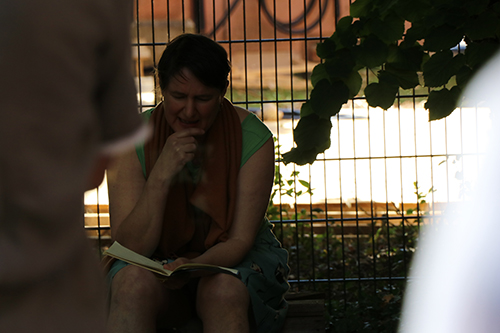
Andrea Saemann, Kino Stella, 17.6.2017. Performance anlässlich von Legs Basel, Ausstellungsraum Klingental, Basel. Photo: Priyanka Govil
[en]
I develop performances alone, in a duo, in a collective and show them at performance events and festivals. I like to burst into a situation, talking. I research and perform researches like edifices and architectures of ideas. This leads to performing and curating events, to putting my own perspective as a viewer up for discussion and at one’s disposal.
Seeing. Being in the space with the performance and then. Having been part of it and then. Immediately after it and right away: writing. Thoughts, movements, excursions, absences.Crossing the river with a boatload of impressions, emotions, presences, creating words with paper and fishing in the abundance.
Tapping fresh memories. Indeed, writing.
Dorothea Rust
AHaeni-m.jpg)
Dorothea Rust, Canonball Bard 1. Photo: A. Häni
[de]
P, wir wissen und wissen nicht von was wir reden und doch müssen und wollen wir reden
P, reden über und davon gehört zu uns wie Socken und Haferflocken, Turnschuhe und Nachtruhe
P ein Buchstabe, ein Wort, ein Un-Ding, eine Situation, ein Trend, eine Kurve
P nicht ein einzigartiges, ephemeres Ereignis, das wie eine Luftblase verpufft
P einzigartig, immer anders, erwischt uns reell und redlich auf dem Hinterfuss
P jetzt gerade überhitzt, gehypet und geliket
P doch nicht zu fassen, immer noch Rares, aber auch algorithmisch Bares
P eine momentane Störung, ein Funke im System, ein Faden der Ariadne in einem Labyrinth mit vielen Ausgängen, wieder aufgegriffen, nicht nur von mir auch von Anderen und dir
P gehört nicht mir, ist Teil eines Milieus*, in dessen Strömung wir uns bewegen, zu dem ich, die/der Andere und viele Andere und viel Anderes ebenso gehören
P ist im Kontext
* Über den Begriff Milieu bin ich bei Jean-Luc Nancy gestolpert. Milieu sei, wo ein Dasein als Mitsein verfasst sei, wo Einzelne nur als Pluralität gegeben seien und doch eines Mittlers nicht bedürften, weil das Milieu des ‚mit’ zwischen den miteinander existierenden Singularitäten eine ursprüngliche Verwandtschaft, eine Gleichartigkeit schaffe, die in der Materialität ihrer Körperlichkeit bestehe.
Aus: Sybille Krämer: Medium, Bote, Übertragung – Kleine Metaphysik der Medialität, 2008 , S. 54 – 66
[en]
P, we know and we don’t know what we are talking about and yet we have to talk, should talk
P, talking about and of it belongs to us like socks and oats, sneakers and heaters
P a letter, a word, a thing, an absurdity, a trend, a situation and a bend
P not an ephemere single incident, fizzling out like an air bubble in an event
P singular, always different, catches one honestly and candidly on the wrong foot
P actually overheated, hyped and liked
P yet hard to catch, as such a noteworthy dash, but also algorithmically hard cash
P a momentary interference disruption, a spark in the system, a thread of Ariadne in a labyrinth with many exits, picked up again and again, not only by me, also by others and by thee
P doesn’t belong to me, it’s part of a milieu* to which the other and many others and other things also belong
P is in context
* I came across the concept of milieu in Jean-Luc Nancy. Milieu as such, where being is conceived as being-with-others, where individuals only exist as a plurality, and yet an intermediary is not required, hence the milieu of with creating between the co-existing singularities an original kinship, a similarity (homogeneity), existing in the materiality of their corporeality.
Source: Sybille Krämer: Medium, Bote, Übertragung – Kleine Metaphysik der Medialität, 2008 , pp. 54 – 66
